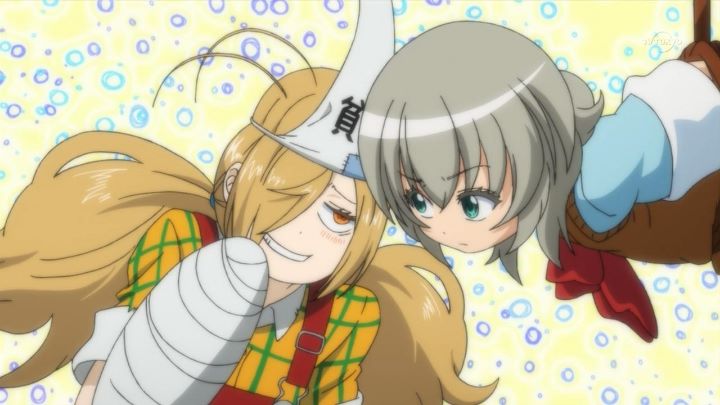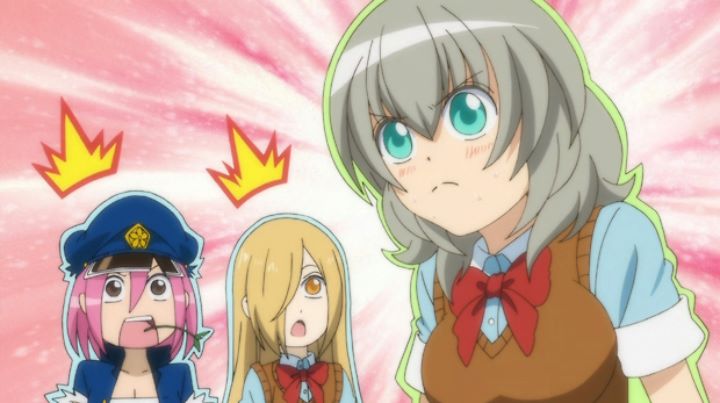




The opening title sequence to the thirteen-episode series "Good Luck Girl!" (known as "Binbogami Ga!" in Japan) consists of a chipper theme song ("Make My Day!") and showing the two main characters chasing and fighting each other, until finally giving up and leaning against each other as if old friends. This is almost a spoiler to the story, but gives a good idea of what to expect. This is a upbeat comedy, featuring main characters that can be thought of as friendly rivals like Tom and Jerry or Sylvester and Tweety. They are constantly at each other's throats, and would have killed each other long ago had it been a cartoon, but ultimately grow fond of each other like best friends despite the squabbles. Depending on your mood, this might be exactly the type of show you want to brighten your day.Alternatively, the ending credits consist of these two characters lost in thought while cosplaying in different costumes, the main girl being given particularly suggestive clothing. While this type of fanservice is not unusual to anime in general, it is a small part of the show, such that it is strange to put it there at all... and when it does show on screen, it only draws attention to itself. This is part of the problem. Some good ideas exist in the show, and ultimately "Good Luck Girl!" can be a fun time, but not focusing on what to be it can leave an audience divided. Speaking of being inspired by wacky cartoons, the plot fits well into that mold. Ichiko is a high school student that makes the boys swoon and the girls jealous. She has everything: good lucks, wealth, a butler, smarts, athletics, etc. She is quickly visited by a poverty god named Momiji, who explains to her that the world relies on the balance of good luck and bad luck, and somehow Ichiko is absorbing all the good luck from those around her, thus giving her a great life while making others miserable.This story has some potential for drama through seeing the heartache of Ichiko's close friends and family, and could have delved into the lore regarding the cycle of luck and how Ichiko started absorbing extra luck in the first place. But it was decided this would be a comedy first. Yes, the overall arc does utilize some of that drama, and no, we don't learn much of the supernatural elements of how luck works. But much of this is handled by the end of the first episode, wherein Ichiko uses some of the stolen good luck from Momiji to help her dying butler, is successful, and then vows to simply not get close to anyone and continue enjoying her perfect life. Thus begins the misadventures: Momiji keeps trying to use increasingly outlandish tricks to steel that good luck to put the world into balance, and Ichiko keeps escaping through her skill and/or her dumb luck. Often, things end with cartoon violence, sending someone falling off a building or into the sky in nearly every episode. To keep things fresh, extra side characters come into their lives, including a butch female student, a perverted black monk, and a transforming dog who has a fetish for pain. Classy. So the story is simple. You know how it ends. Ichiko eventually understands she can't stay distant from everyone for their safety, and that she can still be happy by spreading her happiness energy to those around her. Let's talk about that comedy now.I don't think I've seen an anime so closely resemble the humor of a Saturday-morning Looney Tunes cartoon. "Good Luck Girl!" has the energy and over-the-top violence through outrageous setups that could only happen in animation. But beyond that are the references... in every episode, there are some (and sometimes several) visual references to other anime. Have you heard of Lupin the Third? Conan the Detective? DragonBall Z? Death Note? If you have heard of "Good Luck Girl!," then you probably are familar with some anime culture, but even then some references are so obscure and quick they would be certain to fly over your head. But I''ll give credit to the effort. I can't remember anything with so many homages, and I'll never know how they got away with it without copyright issues.For a comedy, is it funny? Sometimes, yes. Much of that comes from the voice cast: again, credit is due to Funimation's English actors for clearly having a fun time with the show. But some of the jokes are more than a little inappropriate, at least in English, where some quick off-hand comments from characters are downright nasty, the kind of smack-talk you might hear exclusively between girls in a locker room. I had to rewind the video a few times to be certain I heard the joke correctly. Never mind the pervert jokes from the side characters... in a gag show so inspired from Saturday-morning cartoons, why are these jokes in here? The show does break the fourth-wall a few times, including mentioning that it was originally aired after midnight in Japan, so the writers knew what they were doing. But the sex jokes are few enough that they could have easily been cut out, and feel forced when put in. It's a missed opportunity to have expanded to a larger audience.The character designs are somewhat unique. Momiji in particular wears a plad-shirt with an apron and is always missing a shoe. She is a poverty-God afterall, the image speaks well to that, and it is nice to see a representation of a body-type that does not typically appear in anime. Are the character designs pleasent to look at? Are the backgrounds lush and detailed? Is the animation fluid and kenetic? Not really. It all feels like a sub-standard broadcast anime, and coming from studio Sunrise, that is more than a little disappointing.The merit in "Good Luck Girl!" is in its cultural references, its fast-paced cartoon hijinks, and the sheer fun the actors had in the script. Its a good time to watch on a whim if you are looking for that type of comedy. It offers these in a way that is different from most examples of anime, but you shouldn't expect much else.
So the story is simple. You know how it ends. Ichiko eventually understands she can't stay distant from everyone for their safety, and that she can still be happy by spreading her happiness energy to those around her. Let's talk about that comedy now.I don't think I've seen an anime so closely resemble the humor of a Saturday-morning Looney Tunes cartoon. "Good Luck Girl!" has the energy and over-the-top violence through outrageous setups that could only happen in animation. But beyond that are the references... in every episode, there are some (and sometimes several) visual references to other anime. Have you heard of Lupin the Third? Conan the Detective? DragonBall Z? Death Note? If you have heard of "Good Luck Girl!," then you probably are familar with some anime culture, but even then some references are so obscure and quick they would be certain to fly over your head. But I''ll give credit to the effort. I can't remember anything with so many homages, and I'll never know how they got away with it without copyright issues.For a comedy, is it funny? Sometimes, yes. Much of that comes from the voice cast: again, credit is due to Funimation's English actors for clearly having a fun time with the show. But some of the jokes are more than a little inappropriate, at least in English, where some quick off-hand comments from characters are downright nasty, the kind of smack-talk you might hear exclusively between girls in a locker room. I had to rewind the video a few times to be certain I heard the joke correctly. Never mind the pervert jokes from the side characters... in a gag show so inspired from Saturday-morning cartoons, why are these jokes in here? The show does break the fourth-wall a few times, including mentioning that it was originally aired after midnight in Japan, so the writers knew what they were doing. But the sex jokes are few enough that they could have easily been cut out, and feel forced when put in. It's a missed opportunity to have expanded to a larger audience.The character designs are somewhat unique. Momiji in particular wears a plad-shirt with an apron and is always missing a shoe. She is a poverty-God afterall, the image speaks well to that, and it is nice to see a representation of a body-type that does not typically appear in anime. Are the character designs pleasent to look at? Are the backgrounds lush and detailed? Is the animation fluid and kenetic? Not really. It all feels like a sub-standard broadcast anime, and coming from studio Sunrise, that is more than a little disappointing.The merit in "Good Luck Girl!" is in its cultural references, its fast-paced cartoon hijinks, and the sheer fun the actors had in the script. Its a good time to watch on a whim if you are looking for that type of comedy. It offers these in a way that is different from most examples of anime, but you shouldn't expect much else.